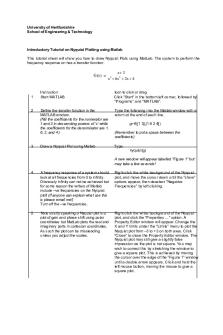Lab3 - Summary of Lab 3 using MATLAB PDF

| Title | Lab3 - Summary of Lab 3 using MATLAB |
|---|---|
| Author | Niki Nia |
| Course | Introduction to Multimedia |
| Institution | Ryerson University |
| Pages | 2 |
| File Size | 115.8 KB |
| File Type | |
| Total Downloads | 85 |
| Total Views | 159 |
Summary
Summary of Lab 3 using MATLAB...
Description
CPS621 Lab 3 Due Wednesday, March 10th, at 11:59pm Purpose • Understand the basic principle of audio processing. • Learn to create music with Matlab. Work to Do 1. Have a read of related lecture notes and some online material provided at the end of this document. 2. Have a watch of the online tutorial of “Make a song by fundamental frequency by Matlab” https://www.youtube.com/watch?v=HG35mFxPuzU 2. Choose an easy music melody you want to create. Some examples can be found at https://takelessons.com/blog/easy-piano-songs-for-kids. Feel free to choose your own melody. 3. Choose the sampling frequency fs=44100 and generate the necessary notes you need for your chosen melody. Then, generate the melody and save it in the following three file formats: (1) “.wav” with BitsPerSample=24; (2) “.wav” with BitsPerSample=8; (3) “.mp4” with default parameters. 4. Change the sampling frequency to fs = 8000 and generate another set of three audio files as in Step 3. 5. Check the length of your melody and compute the theoretical file sizes corresponding to the two sampling frequencies (44100 and 8000) and the two bit depths (24 and 8) you used in Steps 3 and 4. Then, check if they are equal to the real file sizes you generated. Report Your report should include the following contents: 1. A brief review of Nyquist Theorem and pulse code modulation (PCM) in 1-2 paragraphs. 2. A brief summary of your chosen melody and how you generate and save the melody (i.e., the key Matlab scripts). 3. The computation details and results of the file sizes in Step 5, the real file sizes you saved in Steps 3 and 4, and brief analysis of why your computation results are equal or not equal to the real file sizes? 4. After listening to all the files you generated, can you tell the difference between them? Why? 5. Only include the source code of Step 3 in your report. Do not submit your generated sound files.
1
Requirements • The lab report is due on Wednesday, March 10th, at 11:59pm. Late submissions will not be accepted. • Submit all your work in one PDF file through D2L. • Use IEEE double-column format. The Word and LaTeX template can be found at http://www.ieee.org/conferences_events/conferences/publishing/templates.html • Please resize all images properly in line with the text of your report. • Submit the source code along with the report of each part. • You can directly use available functions or software packages of Matlab in your work. • Complete the report by yourself and give proper citations of all sources you referred to. We will use Turnitin® for similarity check. • Start your report for each part with a new page. Resources Here are some online resources you may need for this lab: 1. The sample Matlab code and tutorial for your reference https://www.mathworks.com/matlabcentral/fileexchange/65665-make-a-song 2. Piano key frequencies https://en.wikipedia.org/wiki/Piano_key_frequencies 3. Some easy melodies https://takelessons.com/blog/easy-piano-songs-for-kids 4. Some related Matlab help documents https://www.mathworks.com/help/releases/R2015b/matlab/ref/audioread.html https://www.mathworks.com/help/releases/R2015b/matlab/ref/sound.html
2...
Similar Free PDFs

Lab3 - Lab 3
- 9 Pages

Lab3 win - Lab 3
- 6 Pages

Lab3 - Lab 3 Manual
- 3 Pages

Lab3 ans - Lab 3 answers
- 5 Pages

Copy of LAB3 - Lab 3 assignment
- 3 Pages

ECE 265 Lab3 - LAB 3
- 4 Pages

Lab3 - MIS 307 lab 3
- 8 Pages

Lab3 - Lab Report
- 15 Pages

Voice Recognition Using Matlab
- 20 Pages

Nyquist using Matlab - Practical
- 2 Pages

PHY G7 Lab3 - Lab
- 6 Pages

ECE241 lab3 ref - lab
- 4 Pages

Lab 3- Little g - PHY 207-lab3
- 12 Pages
Popular Institutions
- Tinajero National High School - Annex
- Politeknik Caltex Riau
- Yokohama City University
- SGT University
- University of Al-Qadisiyah
- Divine Word College of Vigan
- Techniek College Rotterdam
- Universidade de Santiago
- Universiti Teknologi MARA Cawangan Johor Kampus Pasir Gudang
- Poltekkes Kemenkes Yogyakarta
- Baguio City National High School
- Colegio san marcos
- preparatoria uno
- Centro de Bachillerato Tecnológico Industrial y de Servicios No. 107
- Dalian Maritime University
- Quang Trung Secondary School
- Colegio Tecnológico en Informática
- Corporación Regional de Educación Superior
- Grupo CEDVA
- Dar Al Uloom University
- Centro de Estudios Preuniversitarios de la Universidad Nacional de Ingeniería
- 上智大学
- Aakash International School, Nuna Majara
- San Felipe Neri Catholic School
- Kang Chiao International School - New Taipei City
- Misamis Occidental National High School
- Institución Educativa Escuela Normal Juan Ladrilleros
- Kolehiyo ng Pantukan
- Batanes State College
- Instituto Continental
- Sekolah Menengah Kejuruan Kesehatan Kaltara (Tarakan)
- Colegio de La Inmaculada Concepcion - Cebu


